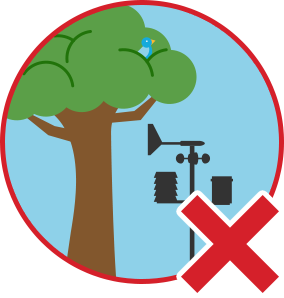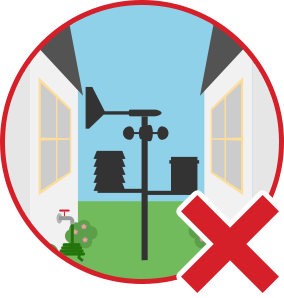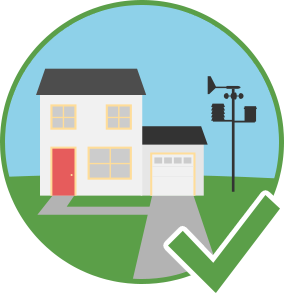Installing your Personal Weather Station
The location of your weather station is the most important part of installation. If your weather station is located under a tree or an overhang, the rainfall data measured by the station will not be correct. If you place your weather station in an alley, you could very well get a wind tunnel effect on the anemometer, resulting in erroneous wind data. Your weather station should have good "fetch", or distance from any other tall object.
Installation Guide
In order to report accurate weather information you must take care in deciding where to place your weather station. The process of deciding how and where to install your weather station is called "Siting". Siting is the single most important factor in ensuring accurate readings. In fact, siting influences the accuracy of weather readings much more than the quality of the weather instruments themselves.
Temperature
The most common error in installing a weather station is associated with misplacing the thermometer sensor. Meteorologists define temperature as the temperature in shade with plenty of ventilation. When placing your weather staion, make sure:
- The thermometer sensor never receives direct sunlight.
- The thermometer receives plenty of ventilation and is not blocked from the wind.
- If the thermometer is placed on a roof-top, make sure it is at least 5 feet above the roof-top.
- If the thermometer is placed above grass, again, it should be at least 5 feet above the grass surface.
- The thermometer is at least 50 feet from the nearest paved surface.
Suggestion - use a radiation shield for your thermometer. This way, your weather station can be placed in direct sunlight, with the thermometer located inside the radiation shield.
- Ambient Weather sells radiation shields. If you purchase from Ambient Weather, use coupon code "wunderground" to receive a 10% discount.
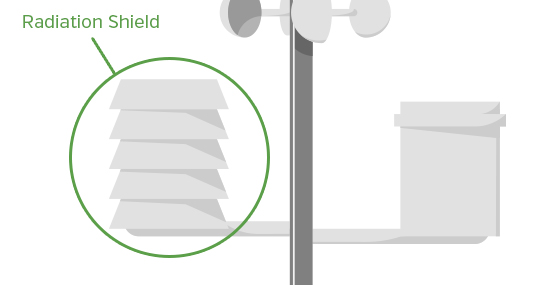
- Some radiation shields have "aspirators" which is a fan that ventilates the thermometer. This ventilation helps a great deal, especially on hot and still days.
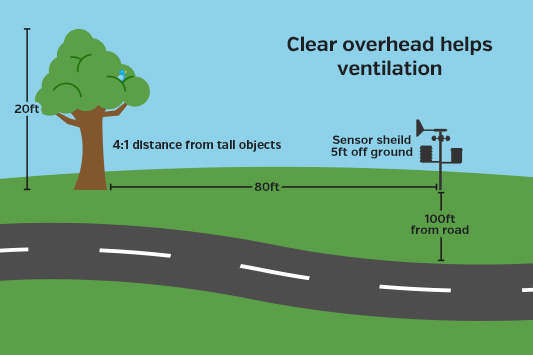
- A cheaper solution if you cannot use a radiation shield is to use a sheet of aluminium mounted about 6 inches from the thermometer. This aluminium sheet should shield the sun at all times and have plenty of ventilation.
Humidity
Humidity measurements should reflect the humidity of the general atmosphere in your location. Plants and bodies of water influence humidity measurements. Hence, make sure the humidity sensor is at least 50 feet away from the nearest tree or body of water.
Rain Collector
You want the Rain Collector (or, Rain Gauge) to receive rainfall as if it were in the middle of a large field. Nearby buildings create "shadows". Imagine if there's a building nearby to the west, and it is raining with a west wind. In such an event, your station's rain collector is bound to miss a lot of falling rain because of the "shadow" cast by the building. As a rule of thumb:
- The rain collector should be placed with at least 5 feet horizontal clearance from the nearest obstruction.
- If a nearby obstruction is just over 5 feet away, that obstruction should be no more than 10 feet tall.
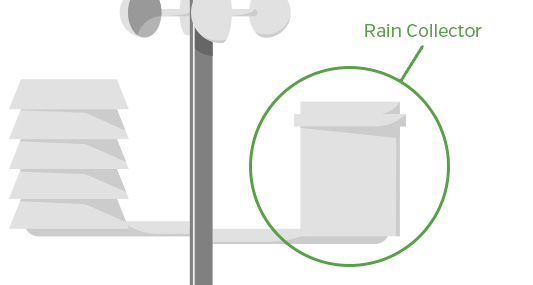
Wind Speed and Direction
Similar to a rain collector, the anemometer should reflect the wind patterns as if the instrument was placed in a large field.
- The standard wind measurement should be taken at 10 meters (33 feet) above the ground. A roof-top works the best. Try to place the anemometer as high as is convenient.
- Try to make the anemometer the highest object around. 7 feet or more above the surrounding obstructions is best.

